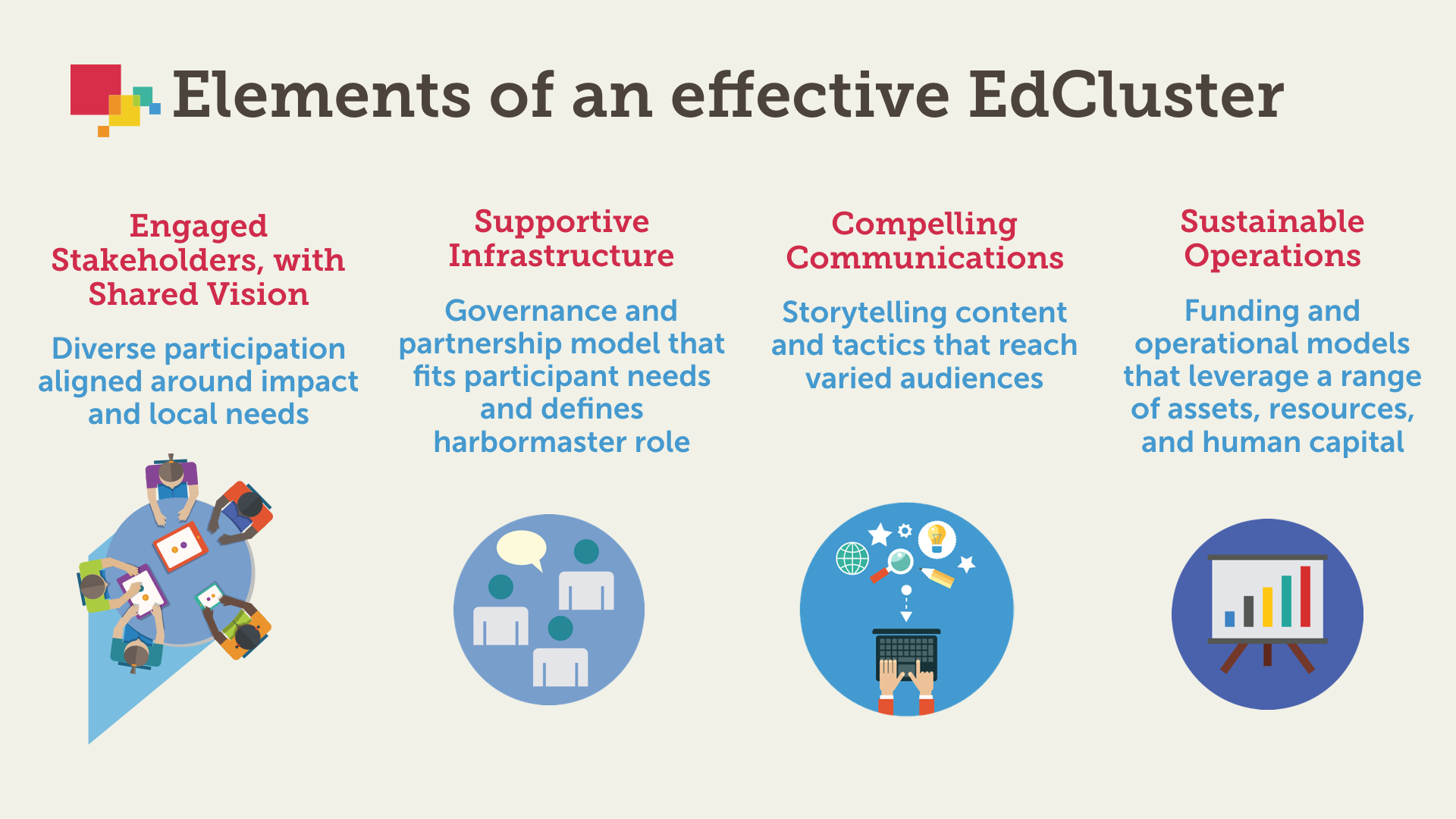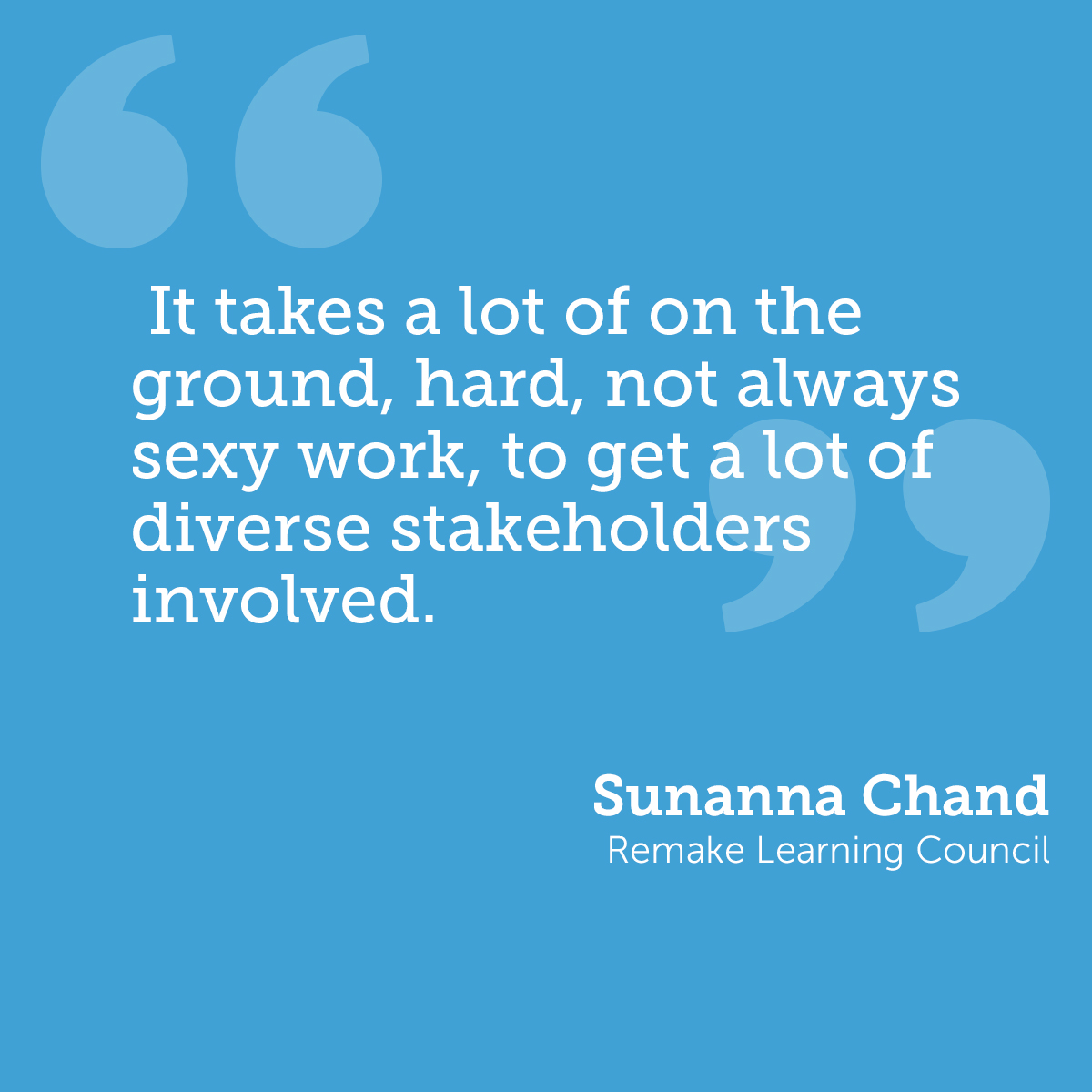
Across the nation, local Education Innovation Clusters (EdClusters) have formed in order to nurture breakthrough learning tools, technologies, and practices; implement these innovations in learning environments; and iterate rapidly based on best available insights. By bringing together educators, entrepreneurs, researchers, funders, and other community stakeholders, EdClusters have an opportunity to accelerate the pace of innovations that support transformative teaching and learning.
So how do these networks come together? What makes these ecosystems work? Each region is unique, with its own goals, partnerships, and programs. But from our work over the past couple years, we’ve distilled four key elements that make an effective EdCluster.

First, and most importantly, as you’ll hear from EdCluster leaders in the video below, is strong stakeholder engagement. Successful clusters are those that bring together a range of voices — paying special attention to those voices that aren’t always included — around a shared vision for innovative learning in their community. When the eduvateRI cluster was building their network in Rhode Island, their philosophy was “the more the merrier,” explains Dana Borrelli-Murray, executive director of the Highlander Institute in Providence, Rhode Island. The key is to ensure this diverse participation is aligned around impact and local needs.
Malliron Hodge is the Community Manager for 4.0 Schools in New Orleans, Louisiana. When it comes to building impactful partnerships and programs for the community, she says, “It’s all about finding out what the user wants first and then moving forward from that instead of making assumptions about what the users want and then creating that.”
Second on our list for what makes an effective EdCluster network is supportive infrastructure. Some regions have formal partnerships, others collaborate informally. Different governance models — from non-profits to consortiums, fiscally-sponsored initiatives to voluntary associations — fit the needs and goals of different regions. Successful EdClusters also clearly define a harbormaster — the local convener or steward of an EdCluster. It’s the organization or individual(s) with primary responsibility for pulling together, catalyzing, and coordinating the activities of the various organizations within the cluster.
Third, effective EdClusters use compelling communications — both within the network and to engage new partners to support their work. Strong EdClusters leverage a range of storytelling content and tactics tailored to reach varied audiences. They ask: What are our successes? What is our impact? How will we share it with our community? What will we ask them to do?
 Finally, successful EdClusters are those that have sustainable operations. They do this by building funding and operational models that leverage a range of assets, resources, and human capital. Some clusters have direct philanthropic funding to support their network infrastructure. Others leverage traditional grant or public funding to bring multiple partners together around a particular initiative. Still others function well with partners who offer in-kind contributions of their time and resources. In others, a harbormaster organization will take on the responsibility for sustaining the resources required for much of the EdCluster activities.
Finally, successful EdClusters are those that have sustainable operations. They do this by building funding and operational models that leverage a range of assets, resources, and human capital. Some clusters have direct philanthropic funding to support their network infrastructure. Others leverage traditional grant or public funding to bring multiple partners together around a particular initiative. Still others function well with partners who offer in-kind contributions of their time and resources. In others, a harbormaster organization will take on the responsibility for sustaining the resources required for much of the EdCluster activities.
What’s true of strong Education Innovation Clusters across the board, however, is that they are paying attention to these four elements, starting with stakeholder engagement. Sunanna Chand, of Pittsburgh’s Remake Learning Council (a blue-ribbon council that serves alongside The Sprout Fund as the harbormaster of the region’s Remake Learning Network) explains the effort involved in that work: “It takes a lot of community organizing. It takes a lot of on the ground, hard, not always sexy work, to get a lot of diverse stakeholders involved.”
But the rewards of these partnerships are clear. Pittsburgh’s Remake Learning Network now includes more than 250 organizations collaborating to accelerate next-generation learning across southwestern Pennsylvania.
For more information about or resources on Education Innovation Clusters, email clusters@digitalpromise.org.